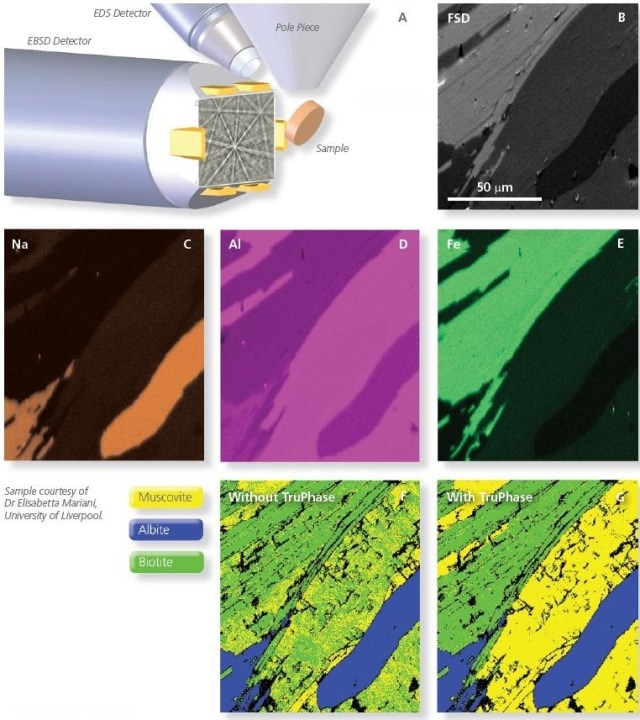Band detection, a critical aspect of electron backscatter diffraction (EBSD), is very important in terms of data quality. Enhancements in band detection can help in maximizing the number of properly indexed points, particularly for materials having low quality patterns or indistinct bands, like those consisting of microstructures that are highly strained or partly recovered.
In contemporary systems, the band detection utilizes an advanced algorithm that helps in determining which of the detected bands can be used in the indexing. This technique employs a weighting function based on the band position and the average intensity of the band within the area of interest, that is, the region of the EBSP utilized to detect the band.
More importance is given to those bands that are at, or close, to the middle of the area of interest, and hence bands that are more consistently detected are used in the indexing and ultimately make the indexing highly robust.
However, neither band nor pattern detections are always reliable. The quality of the pattern may be poor or overlapped, and bands may be overlooked. As a result, indexing must be extremely robust.
Indexing Routines
In order to obtain precise information, the indexing routine is very important. However, validated hit rate needs to be achieved without producing false positive solutions, where EBSPs are resolved but with the incorrect solution.
Moreover, automated routines can be highly susceptible to non-fitting bands. As a result, the algorithm applied in the indexing must be sufficiently strong to manage errors in band detection and locate the right solution.
Class Indexing is a method that assesses permutations of four bands, and considers band non-coherence where the reference crystal reflectors and the quantified bands are not in agreement, and band coherence, where the reference crystal reflectors and quantified bands are in agreement.
Through these four-band integrations, the solutions are broken down by the indexing routine into smaller blocks, making them the foundations of the indexing. Even when one or more bands are non-coherent, the routine is much more robust and can locate the right solution.
As a rule, there have always been some complexities when the EBSD technique was used to differentiate phases having identical crystal structures. This is because this method typically employs only the angles between the bands for phase identification. One method to overcome this issue is to utilize the variations in band width or lattice parameter. If this is adequate, the difference in the band widths can be used to differentiate these phases.
An alternative is to integrate the EBSD indexing routine with input data based on the sample chemistry, by obtaining energy dispersive spectrometry (EDS) and EBSD data simultaneously, for instance through the AZtec TruPhase routine (Figure 1).

Figure 1. Combined EDS and EBSD analysis of a geological sample. This area of the sample contains 3 mineral phases: albite, biotite and muscovite mica. Biotite and muscovite mica have very similar crystal structures and therefore can be difficult to differentiate on the basis of traditional EBSD.
This can be utilized when both EBSD and EDS are properly assembled on the scanning electron microscope (SEM), enabling both to operate in the same geometry simultaneously.
Refined Accuracy
Accurate identification of orientation depends on precise detection of band positions and thus indexing. When there is a need for precise misorientation measurements, the Refined Accuracy mode in Aztec can be utilized. When compared to traditional (Hough-based) techniques, this method enhances the accuracy of misorientation measurement without compromising the speed.
Following a Hough-based band detection, a secondary band refinement is used by the Refined Accuracy mode that fits the reproduced band to the true band in the EBSD itself and also considers the shape of the band edges. Therefore, the band position, i. e. parameters ρ and θ, is more precisely measured and results in better accuracy in orientation measurement.
Conclusion
EBSD developments such as band detection, indexing routines, and refined accuracy are essential aspects of EBSD and are important to achieve high data quality. Enhancements in band detection can improve the number of suitably indexed points.
Indexing routine is a robust technique and can detect the right solution even when one or more bands are non-coherent, and the refined accuracy mode in Aztec helps in acquiring high precision misorientation measurements.

This information has been sourced, reviewed and adapted from materials provided by Oxford Instruments NanoAnalysis.
For more information on this source, please visit Oxford Instruments NanoAnalysis.